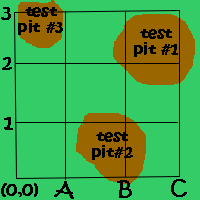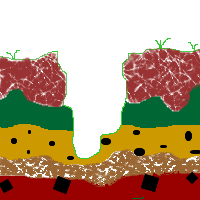


 |
I once was asked what I studied, and when I told that person that I studied Archaeology, he looked at me kind of funny for a minute. Finally, a look of understanding came across his face and he said, “Oh, so, you design buildings, right?” A common profession that people get Archaeology confused with is ARCHITECTURE. Architecture is another big word beginning with ARCH- that is the study and planning of buildings and structures. Archaeology is the study of things LIKE architecture as well as other artifacts from times past. It is also the study of who was in a certain place, what they had with them, when they were there, how they got there, and why they left. As you’ll see when you learn the story of the “Bottle from Iowa” it takes a lot of work with primary resources and other reference material to discover the answers to all of those questions. |
Archaeology gained a lot of popularity in the United States after Thomas Jefferson, known as the "Father of American Archaeology," discovered an American Indian mound site in Virginia. He studied the mound site using the scientific method, and brought the field of archaeology into the scientific world. |
 |
There are now laws, such as the National Historic Preservation Act, which require builders to hire an archaeologist to come and excavate the site before the builder covers it up with a new building. We have to make sure that the past gets recorded so that it is not erased by the advancement into the future. If we can achieve a healthy balance of learning from the past while looking towards the future, the present will be quite a treat to live in! As the next wave of historians and archaeologists, it is your job to get people your age interested in all of this stuff we’ve been talking about! Did you know that there was an archaeological excavation done in Scottsville recently? That’s right, good ol’ Bruce Park is the home of three prehistoric pits from the Late Woodland period (That dates all the way back from 1000-1600AD; over a thousand years old!), and a historic section from the 19th century (remember that 19th century is the same thing as anytime in the 1800's.) Let’s find out a little more about this excavation shall we? The story starts a little bit farther back in time…let’s jump in our Time Machine and set the dials for 1927.
This is the year when Thomas Ellison Bruce purchased the Carlton Hotel property and turned it into the famous Bruce’s Drugstore. This property remained in the Bruce family until Anne Shirley Bruce Dorrier (from the Dorrier family after which Dorrier Park was named) deeded the back of the property to the town for use as Bruce Park. When Bruce Park was being built, the builders noticed some artifacts. Knowing that there could be a lot of important history below the dirt they were standing on, they called in a team of archaeologists from John Milner Associates, Inc. This is what the JMA team did: |
 |
Step One: they visually inspected the ground for the things the builders reported. After they found the areas in question they roped off the site and created a grid on top of the site and on top of their map so they could refer to specific points on the ground by a coordinate (for example: if they found a spoon from the Civil War period they could record that they found it in grid square (A, 3) or wherever it is that they found their information). |
Step Two: After creating a grid referencing system, the archaeologists collected the artifacts that they found laying on the surface. They also picked out certain sections to use as TEST PITS. Since they are on a time schedule, they do not have time to dig up the entire area, so they pick test areas that they believe will best represent the whole site. |
 |
 |
Step Three: They begin digging the test pits layer by layer. Digging sites by layers of soil is something that Thomas Jefferson helped start, called stratigraphy. Strata means layers, so stratigraphy means recording information by layers. (Has your mom every made you Cheese Strata for dinner? Cheese Strata is layers of cheese, egg, and bread! Yummy!) If at any point while digging they notice a difference in the type of artifacts they find, or a change in the color of the soil, they have to stop and record that change so they know where a new layer of occupation might be. (You’ll understand more about the layers of occupation by doing the archaeology activity). Not only do they measure the depth of the soil when it changes, but they also take lots of pictures and have someone come and draw what they find. |
Step Four: When they had finished digging the test pits and found as many representative artifacts as they could they again recorded everything they found in writing, with photos, and with drawings. History had been recorded and future progress on the park could continue! |
 |
So there you have it. Seems pretty logical right? Find a site, put a grid on the site and your map, dig some test sites, and record everything you see! Are you ready to be an archaeologist? I think so! Onward now to find out more about the Monacan Indians and then two activities about archaeology! In one of them you get to eat your results!
|